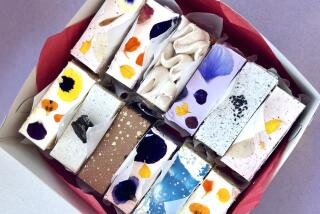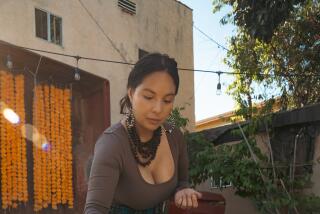Don’t Be Afraid: It’s Simply Perfect Chocolate
- Share via
Alice Medrich feels uneasy. She’s concerned the elegant photographs in her book “Cocolat” (Warner Books, 1990: $35) will intimidate people. “I don’t want them to see the desserts as so perfect they think they could never do that, because they can with my help.”
Take the marbled glaze pictured on her version of Queen of Sheba cake, for example. At first glance it’s hard to fathom the technique used to create this effect, but Medrich’s instructions in the chapter on finishing techniques reveal it’s really very easy. She demonstrated this procedure along with two others on a recent visit to The Times Test Kitchen.
Most chocolate tortes rise like a souffle while baking, then fall in the center as they cool, explained Medrich. Because of this, the cakes must be leveled prior to glazing. Before removing the torte from the pan, run a small metal spatula between the cake and pan sides, then simply press the raised edges down with your fingertips (Step 1) until they are level with the center.
Place a cardboard circle on the torte, release the sides of the springform pan and invert the torte so the bottom becomes the top. Remove the pan bottom and the paper lining (Step 2). If the cake is still uneven, level it again by pressing the top firmly with the bottom of the empty cake pan.
These tortes may be served plain, but they can also be decorated with a variety of techniques--most of which are interchangeable.
Medrich suggests using stencils as one easy way to finish a dessert. Powdered sugar, cocoa, ground cinnamon, pulverized nuts or grated chocolate make good dusting materials, alone or in combination.
Doilies are often used as stencils, but Medrich also includes directions for making custom designs. In the section of additional tips, she recommends using a very fine strainer and gently tapping it on the side (Step 3) to control how heavy the dusting material falls. The stencil must be carefully removed (Step 4) so as not to smudge the design.
When cakes are to be finished with a glaze, they must first be crumb-coated. This is a thin layer of cooled chocolate glaze spread over the torte (Step 5) to smooth the surface, fill cracks and “glue” on loose crumbs. The crumb coat will not be glossy or attractive, warns Medrich, but it provides a smooth, even undercoat for the final glaze.
Refrigerate the torte about 10 minutes, or just until the crumb coat is set. If the coating becomes too cold, it will dull the final glaze.
Meanwhile, rewarm the remaining glaze in a barely simmering water bath for a few seconds, stirring gently until the glaze is perfectly smooth. It should be between 90 and 92 degrees and the consistency of heavy cream.
Center the crumb-coated torte on a platter or turntable. Have ready a clean, dry metal icing spatula. Pour all the glaze in the center of the top of the torte (Step 6). Working quickly, use two or three spatula strokes to spread the glaze over the top and let it run down over the sides (Step 7). Turn the platter or turntable as you spread the glaze.
Use the spatula to scoop up excess glaze and cover any bare spots on the sides. Jiggle or rap the turntable gently to settle uneven glaze or spatula tracks. Do not respread or resmooth once the glaze has started to set or the finished torte will show spatula marks and dull streaks.
Once the torte is glazed, slide a wide spatula underneath and remove it to a rack to dry at room temperature. Keep the torte as level as possible while lifting and transferring so the wet glaze on top doesn’t shift before setting. The glaze will set in 10 to 20 minutes.
Marbling the top requires some advance preparation so it can be done quickly, before the glaze sets. Melt one ounce of white chocolate and one ounce of milk chocolate in small bowls in a barely simmering water bath. Place each in a small paper cone.
Snip the tips of the cones with a sharp pair of scissors to make a small opening, just large enough to allow the chocolate to flow when the cone is squeezed. Have a fine artist’s brush or a thin wooden skewer handy.
As soon as the torte is glazed, pipe loose loopy scribble over the cake (Step 8). Both colors may be done at the same time, or pipe first with milk chocolate and then overlap with white chocolate.
Using a series of bisecting strokes, draw the brush across the edges of the cake (Step 9), letting each stroke cross over the previous one, continuing around the cake and gradually moving in toward the center. Finish the sides by pressing on coarsely chopped hazelnuts (Step 10).
For an alternate finishing technique, the melted chocolates can be piped in a zigzag pattern. Beginning at the center, pipe five free-form milk chocolate figures around the cake, then overlap with five made from white chocolate (Step 11).
CHOCOLATE HAZELNUT TORTE
6 ounces bittersweet or semisweet chocolate
6 ounces unsalted butter
4 eggs, separated
3/4 cup granulated sugar
1/2 cup ground toasted hazelnuts
1/4 cup flour
1/8 teaspoon cream of tartar
Powdered sugar, optional
Bittersweet Chocolate Glaze, optional
1 ounce milk chocolate, optional
1 ounce white chocolate, optional
Toasted chopped hazelnuts, optional
Line bottom of 8-inch round, 3-inch deep springform or round cake pan with circle of parchment or wax paper. Set aside.
Cut chocolate and butter into small pieces and place in small bowl. Melt in barely simmering water bath over low heat, stirring occasionally, until completely melted. Or, microwave on MEDIUM (50% power) about 2 minutes. Stir until smooth and completely melted.
Beat egg yolks with 1/2 cup granulated sugar until pale and thick. Stir in warm chocolate mixture, ground nuts and flour. Set aside.
Beat egg whites and cream of tartar at medium speed until soft peaks form. Gradually sprinkle in remaining 1/4 cup granulated sugar, beating at high speed until stiff but not dry.
Fold 1/4 egg whites into chocolate batter to lighten, then quickly fold in remaining whites. Turn mixture into prepared pan.
Bake at 375 degrees 40 to 45 minutes, or until wood pick inserted in center shows moist crumbs. (Torte will rise like souffle during baking, but will fall in center while cooling, leaving faintly crusty higher rim around edges.) Cool torte completely in pan on wire rack.
Level torte before removing from pan by running small metal spatula or knife between edges of torte and sides of pan. Press raised edges of torte down with fingers until level with center.
Place cardboard cake circle on torte (release sides of springform pan, if used). Invert torte so bottom becomes top, then remove pan bottom and paper liner.
If torte is still uneven or appears slightly sunken in center, level again by pressing top firmly with bottom of empty cake pan. (Torte may be prepared to this point up to 3 days in advance. Wrap well and store at room temperature or freeze up to 3 months. Bring to room temperature before serving, glazing or decorating.) Makes 10 to 12 servings.
To Stencil Torte: Place desired stencil over top of unglazed cake. Place powdered sugar in very fine sieve and hold few inches above stencil. Gently tap side of sieve, moving over stencil until entirely covered. Carefully remove stencil.
To Glaze Torte: Use metal icing spatula to spread about 1/4 Bittersweet Chocolate Glaze in thin layer over top and sides of torte. Smooth rough surface of torte, securing loose crumbs and filling any cracks. (Crumb coat will not be glossy or attractive. Sole purpose is to provide smooth, even undercoat for final glaze. Use care not to get any crumbs in remaining glaze.)
Refrigerate torte about 10 minutes, just until crumb coat is set. Do not chill more than 10 minutes, however, or torte will become cold throughout and dull final glaze.
Rewarm remaining cooled glaze by placing bowl in barely simmering water bath few seconds, stirring gently until glaze is perfectly smooth, 90 to 92 degrees, and consistency of whipping cream. Do not overheat.
If glaze is accidentally overheated, cool again to proper temperature before using. If there are any crumbs or air bubbles in glaze, pour through fine strainer just before using.
Center crumb-coated torte on platter or turntable. Have ready clean, dry metal icing spatula. Pour all of glaze in center of top of torte. Working quickly, use 2 to 3 spatula strokes so glaze spreads over top of torte and runs down all sides. Turn platter or turntable as glaze is spread.
Use spatula to scoop up excess glaze and cover any bare spots. Jiggle or rap turntable gently to settle uneven glaze or spatula tracks. Do not respread or resmooth once glaze has started to set, or finished torte will show spatula marks and dull streaks.
Bittersweet Chocolate Glaze
6 ounces bittersweet or semisweet chocolate
4 ounces unsalted butter
1 tablespoon light corn syrup
Cut chocolate and butter into pieces. Place in small bowl along with corn syrup. Melt gently in water bath over low heat, stirring frequently, until almost completely melted.
Remove glaze from water bath and set aside to finish melting, stirring once or twice until glaze is perfectly smooth. Or, melt in microwave on MEDIUM (50% power) about 2 minutes. Stir mixture gently with spatula or wooden spoon until completely smooth. Do not whisk or beat.
Cool glaze, without stirring, until nearly set and consistency of easily spreadable frosting.
More to Read
Eat your way across L.A.
Get our weekly Tasting Notes newsletter for reviews, news and more.
You may occasionally receive promotional content from the Los Angeles Times.










